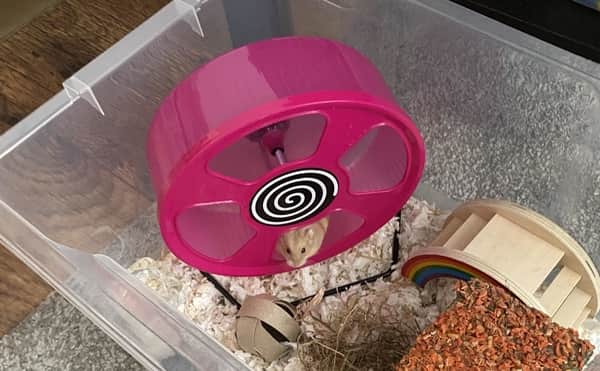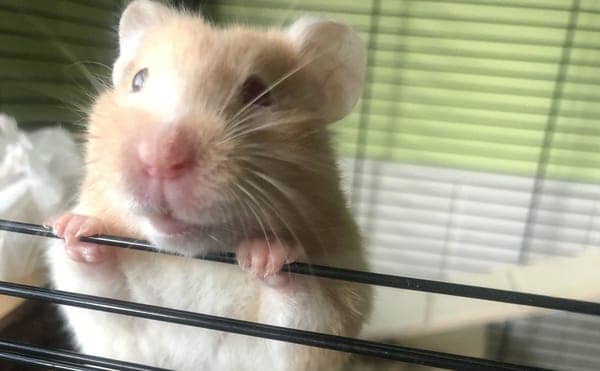Hamsters are among the quirkiest of all the companions we bring into our homes, so it should come as no surprise when they display odd behaviors like running on top of their wheel instead of in it. No need to fear, however, as there is likely a reasonable explanation for this behavior.
So, why does my hamster run on top of his wheel? The most likely reason why your hamster is running on his wheel instead of in it is because his wheel is too small for his body, although other factors may come into play.
In this article we will discuss how the size of your hamster’s wheel and the amount of energy hamsters need to burn every day. We will also cover how sometimes odd behavior like this can be a sign something is wrong, and the fact that perhaps your hamster simply does not have it all figured out yet.
Bigger Is Better!
Hamster wheels are perhaps the most recognizable aspect of a domestic hamster’s domicile; any time one thinks of a pet hamster, a mental image of a tiny ball of fluff running furiously in their exercise wheel is usually what appears. The wheel is a quintessential part of a hamster’s habitat for good reason—hamsters have a natural need to run.
In the wild, they are known to run miles in search of food, not to mention away from predators, so it stands to reason their domestic counterparts have just as strong a desire to run. But what is happening when your companion starts running on top of its wheel instead of in it?
If your hamster prefers running on top of its wheel it likely is because the wheel is too small. It is hard to believe that a space could be considered too small for such a small creature, but a properly sized wheel is incredibly important for the health and safety of your pocket-sized pal.
To determine if this is the case, observe your hamster if/when it tries to run inside the wheel, or try your best to recall the last time this took place. Does your pal’s back arch while it runs? Will your hamster run for a while and then hang over the edge of the wheel? Perhaps it does not want to go inside the wheel at all—these are all signals that your wheel is too small.
As a rule, your wheel should be at least 6.5 inches for dwarf breed hamsters, keeping in mind that if it is too big the dwarfs may not be able to push it as easily. Conversely, for larger Syrian hamsters, the wheel should be no smaller than 8.5 inches.
In addition to inducing odd behavior like roof-top running, having a too-small wheel can cause a back injury or curvature in your hamster’s spine that could result in complications over time. Further, the larger the wheel, the more it imitates running on flat ground the way a hamster would run in the wild, which is better for overall health and wellbeing.
Speaking of your pal’s wellbeing, burning energy is directly related to hamster happiness. If there are not enough ways for your companion to exercise, it might be getting creative.

High Octane Hams
In addition to being avid runners, hamsters are also prolific diggers and enthusiastic hoarders. As mentioned earlier, they run miles and miles in search of food every night to store during periods of scarcity.
Hamsters inhabit harsh climates like deserts and steppes, so the need for food stores is imperative. Further, because of these harsh climates and their many predators, hamsters live deep underground.
They continuously dig intricate tunnels that connect multiple rooms in which they store food, sleep, toilet, and raise baby hams! Take into consideration their high-energy, carbohydrate-loaded diet, and all these factors equal a shocking amount of energy packed into tiny little bodies.
Although our housebound hamsters do not have to worry about things like food scarcity or predation, they are only removed from their wild counterparts by about 100 years, meaning their instincts are still incredibly strong.
What this means for you, hamster parent, is that your little pal needs a lot of ways to burn off all that energy or they will start getting creative. Sometimes that creativity manifests in quirks like running on top of their wheel instead of in it, while other times it turns into stress and anxiety, which we will discuss shortly.
To prevent your companion from resorting to acrobatics to burn off energy, ensure there are plenty of sources of entertainment available in its enclosure.
In addition to a properly sized wheel, consider adding tubes through which your companion can scamper—bonus points if the tunnels connect special small rooms or hides in which your pal can store its stash.
Offer plenty of toys, including climbing toys like ladders and hammocks, as well as soft wood chewing blocks, as a hamster’s teeth never stop growing, so chewing is yet another naturally occurring energy burner.
Additionally, make sure there is plenty of bedding in your hamster’s enclosure to give it the opportunity to burrow. You can do this by partitioning an area of your pal’s domicile and adding lots more bedding to the area, or by providing a special box just for digging and burrowing. You can also offer a sand bath, which is exactly what it sounds like: a bath full of sand.
Chances are your pal probably enjoys rolling around in sand to “bathe,” since water baths are not ideal for hamsters. Finally, make sure to offer your hamster closely supervised time outside of its enclosure either in a ball, a special playpen, or a designated room so it can roam and explore the big world that is your home.
If wheel size and entertainment options are not the driving factors behind your companion’s odd behavior, observe the way the behavior is executed to make sure it is not compulsive, as this could signal something is wrong.
Not-So-Typical Behavior
Although our furry friends are usually quirky and joyful, hamsters are prey animals, which means they are basically programmed to be fearful and anxious of almost everything. This kind of stress, albeit difficult to avoid sometimes, can lead to adverse behaviors and mental states in our hams.
If your pal has been running on top of its wheel and seems like it is not 100% in control of its actions, or is zombie-like in their execution, this behavior may be a compulsive, or “stereotypy,” behavior.
A stereotypy is the repetitive execution of a certain behavior for no useful or observable purpose. In hamsters, these behaviors usually are driven by stress. To determine if stress is causing what you may now suspect may be a stereotypic behavior, look for some of the following things as additional signals:
- Hyperactivity
- Unusual habits (bar biting, cage climbing)
- Additional compulsive behaviors (excessive grooming, scratching, or gnawing)
- Uncharacteristic aggression
- Squeaks or grunts
- Repeated escape attempts
While this list is not all-inclusive, it does contain some of the most common behavioral changes demonstrated by stressed out or anxious hamsters. If you are seeing some or all these behaviors in addition to your companion’s new pastime, examine the environment in which your hamster lives to determine the cause.
One of the biggest causes of stress in hamsters tends to be improperly sized enclosures. The minimum recommended size for a hamster cage in the United States tends to be 24 inches by 12 inches, with at least 12 inches of height. However, in the case of hamster housing, bigger is always better.
Furthermore, having plenty of enrichment available, as discussed above, is imperative to a hamster’s mental health. If your enclosure is too small or not well-enough stocked with entertainment options, there has never been a better time for you to upgrade!
In addition to the enclosure itself, the environment surrounding it can have a great impact on your hamster’s health as well. The room in which your hamster resides should be kept dry and temperate, ideally between 65- and 75-degrees Fahrenheit, with gentle lighting and no loud noises or ultrasound.
Common sources of ultrasound in most homes include television sets, computer monitors, and household appliances like dishwashers and washing machines.
Lastly, if other pets live in the same room, specifically “predatory” pets like dogs and cats, try to accommodate them elsewhere, as their presence is sure to cause stress for your pocket-sized pal regardless of how long they have been roommates.
Keeping your furry friend happy, calm, and feeling safe will pay big dividends with the reduction of stress and return to joy and snuggles. However, if you have read this far and nothing sounds like it explains your hamster’s behavior, it could be that they just do not know what to do with their wheel.

What Am I Looking At?
If your happy, stress-free ham has a good-sized wheel in a healthy habitat, it might be running on the top of its wheel because it simply has not figured out that it is supposed to run inside. As intuitive as the wheel might seem, all hamsters are different and each one has unique quirks and their own learning curve, not unlike us humans.
Your hamster, especially if it is new to your home or is still quite young, might still be learning about all the new and wonderful things in its enclosure, wheel included. You can try to teach it how to use the wheel by placing it inside, however, if it ends up preferring its daily run with a view, there is no need for concern.
Just make sure the wheel is on the ground level of the enclosure, if your enclosure has different levels, and add some extra bedding beneath the wheel for padding in the event of a fall.
Finally, try to invest in a wheel made of solid material like plastic or wood vice a wire wheel, so your friend’s feet do not slip through while it runs. If your pal is healthy and happy, running inside or outside the wheel will still give it the exercise it needs.
Conclusion
If your hamster runs on top of its wheel instead of inside, it likely means the wheel is too small. Invest in a larger wheel for your pal to prevent injuries or complications later. Further, your hamster is naturally incredibly high-strung, so if there are not enough options for energy-burning available, it could be getting creative with its wheel.
Make sure there are plenty of enrichment items to keep your friend busy and safe. It is also a good idea to try to rule out stress as a cause of the behavior—identify whether your pal’s behavior is stereotypic and try to determine the root cause by examining its environment.
Finally, consider the possibility that your pal simply does not have it all figured out yet, and still needs time to learn how to use its wheel. In any case, if you do everything you can to help your ham stay happy, healthy, and busy, you will be rewarded with lots of joyful entertainment and love for years to come.



